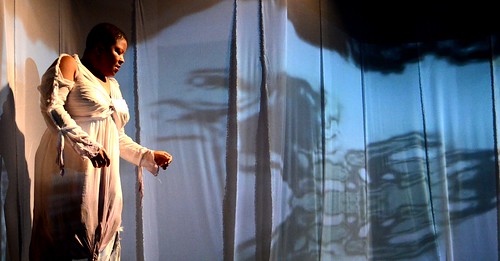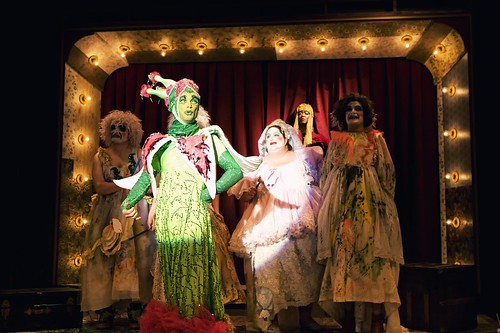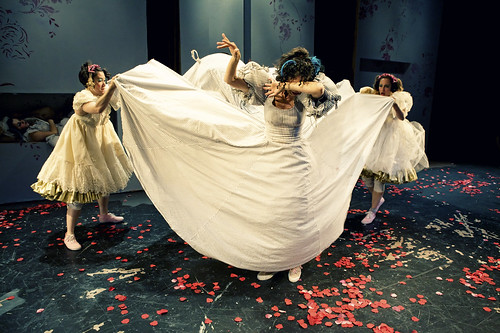Yahya Abdul-Mateen II (left) is Stacey and Armando McClain is Wire in the West Coast premiere of Christina Anderson’s Good Goods, a Crowded Fire Theater production at the Boxcar Playhouse. Below: Mollena Williams is Patricia and Lauren Spencer is Sunny. Photos by Pak Han
A little bit weird (in the most wonderful way) and a whole lot good, Christina Anderson’s Good Goods is a captivating drama that becomes a highly satisfying love story – or love stories to be exact. Crowded Fire Theater is producing the West Coast premiere, with artistic director Marissa Wolf firmly at the helm.
What’s so appealing about this two-act play is that it’s old-fashioned and fresh at the same time, mysterious and yet straightforward enough to be almost instantly engaging. You get a sense of community and real human connection intermingled with the supernatural as in an August Wilson play and abundant romance, betrayal and pining, as in a Tennessee Williams play. But this is not to say that Anderson is being derivative. It’s more like she’s using the best parts of drama to tell an interesting story and keep her audience involved and wondering what the heck is going to happen next.
It’s best not to know too much about the plot (of which there’s no shortage), but it’s OK to know that it all spins out in a small town that is rather out of place and time. There has been a major event – an “invasion” of some kind – in the not-too-distant past that has had a dramatic effect on the area, which is presumably an all-black town in the American south.
The major industry in town is a pencil factory, and that keeps the mercantile of Good Goods – owned by a man whose last name is Good – in operation. The business is ostensibly owned by Mr. Good’s son, Stacey, but he’s been gone for a decade, having hit it big on the comedy circuit with another hometown girl, Patricia. The one actually running the story, or at least keeping it from going under is Truth (“It’s a name you have to earn, that’s for sure”).
As with any good drama, the status quo is disrupted. Stacey returns home to deal not with the disappearance of his father but to revisit a lost love – his childhood friend (and Patricia’s twin brother), Wire. It’s a recognizable world but slightly askew. The set, by Emily Greene, makes the store look like something out of the 1800s, yet one character wears Nike shoes and another listens to a comedian on a cassette player. The time is now (or 1994 to be specific), yet it seems a world away from the modern world. Perhaps that’s why the spirit world is so alive and well here.
There’s talk of a cursed family going back for generations that might be the key to Armageddon, and there’s most definitely visitation from another world, yet somehow these fanciful flights seem just as part of the fabric of this town and these people as the love stories or family dramas.
Wolf’s cast is superb at underplaying the more sensational aspects of the story and imbuing the whole thing with real heart. Yahya Abdul Mateen II is Stacey the prodigal son returned to see if he can reconnect with Wire, played by the vibrant Armando McClain. Their love story is especially touching because it’s clearly meant to be in spite of Stacey’s inability to express himself fully.
Stacey has an easier time fighting with Truth (David E. Moore), a sort of brother figure who is bitter that he’ll likely be forced into work at the pencil factory if Stacey refuses to take over the store. A ray of hope comes into his life with the return of Patricia, played by the luminous Mollena Williams, and her new friend, Sunny, played by Lauren Spencer, an actor who shows extraordinary range in this surprisingly demanding role.
Before this quintet can figure out how their relationships will sever or evolve, the spirit world intervenes, which demands the presence of Anthony Rollins Mullens as a neighbor with talents that extend into various realms. Mullens is, to say the least, a commanding figure, and it’s no wonder the play ends on such a calm note after his hurricane of a scene.
The play zips by at only two hours, and though there are underdeveloped elements – I wanted more from Patricia and her transition into love – it satisfies like few new plays I’ve seen recently. It also feels like it could be the first chapter in an ongoing saga. Here’s hoping.
FOR MORE INFORMATION
Christina Anderson’s Good Goods continues through June 23 at the Boxcar Playhouse, 505 Natoma St., San Francisco. Tickets prices are on a sliding scale. Visit www.crowdedfire.org.






